Soccer drills
1st exercise:
- Player A plays the ball in to B and runs to B's position.
- Player B stands open turned, takes it and passes it to Player C and so on.
- Point of attention playing in:
- the ball must be hit in the middle so that it stays low.
- The correct technique for this is to lift your shooting leg slightly.
- Passing point:
- The player who accepts the ball should not be facing the ball with his or her body, but turned "open". You create this by positioning your body towards the player you are passing to and with your eyes on the ball.
- Playing around clockwise, the ball is taken on with the left and I play on with the right.
- In the other direction take on with the right and play on with the left.
- If you notice it's too easy, first increase the pace. Then to make it more difficult you can take out the assumption and they have to pass the ball directly.
2nd exercise:
- Player B asks for the ball.
- Player A plays into player B.
- Then B then drops the ball to player A after which he passes it back to player C.
- Player C then drops it to player B and then player B plays it diagonally to player D and so on.
Points of attention:
- The player who plays the ball in must move on after the play-in so that he can ask for the ball, in the middle, between the pawns
- Not further because then the effect is gone with the cross pass.
- The player who rebounds runs around his own pawn to ask for the ball again in the middle.
- This player must make the correct turn when rebounding so that he keeps his eyes on the ball.
- His turn should be short toward the box and not off the play.
In both drills after 8 minutes, change directions of play.
Clockwise passes with right leg, counterclockwise passes with left leg.
Clockwise passes with right leg, counterclockwise passes with left leg.
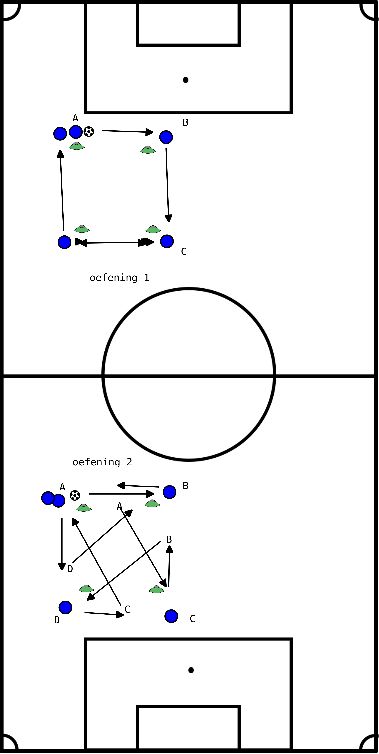
1st exercise:
- Player A plays the ball in to B and runs to B's position.
- Player B is open turned takes it and passes it to Player C and so on.
- Focal point 1 playing in: the ball must be hit in the middle so that it stays low.
- The correct technique for this is to lift your shooting leg slightly.
- Focal point 2 receiving: The player who has to receive the ball should not be facing the ball but rather, as they say, turned open. You create this by positioning your body towards the player you have to pass to and your face is facing the ball. Playing the ball around clockwise, the ball is taken on with the left and I play on with the right. other way round take on with the right and play on with the left.
- If you notice that it is too easy, first increase the tempo. If that also proves too easy then you take out the takeover and they have to pass the ball directly.
2nd exercise:
- Player B asks for the ball, player A plays into player B. Then B drops the ball to player A who then passes it on to player C.
- Player C then drops it to player B and then player B plays it diagonally to player D and so on.
Points of attention:
- The player who plays the ball in must move on after playing in so that he asks for the ball in the middle between the pawns
- Not further because then the cross pass effect is gone.
- The player who bounces the ball back runs around his own pawn to ask for the ball again in the middle.
- It is imperative that this player makes the correct turn when rebounding so that he keeps his eyes on the ball.
- His turn should be short toward the box and not off the play.

- S2 is central and asks ball to S1.
- S1 plays ball in.
- S2 spins out and does double pass to S3 who asks for ball with pre-action.
- S3 takes ball and does slalom with turn on each side and passes with ball to back pot.

- All balls are next to the goal with the trainer.
- The trainer plays the balls to the players.
- The goal is to score. The player who scores stays in the game, while the player who misses or the goalie who stops the ball is out of the game.
- The team with 1 or more players remaining last wins.
- The player who has been goalkeeping makes sure the balls are returned to the coach until players are finished. After that, those players take over.
In groups A through D, players must shoot the ball in front of the 16-yard line. Beyond is off. For groups E through J, the line is halfway between the 5-meter area and the 16-meter line.
- One group starts with goalkeeping, in this case red.
- The trainer plays the ball in and the player from blue runs in and shoots directly at the goal. Don't assume first, then you're off.
- If he hits, he goes goalie and rejoins his group. If he misses, he goes to goal and then collects balls.
- When a player has shot at goal, hit or miss, the next ball from the opponent goes to goalkeeper.
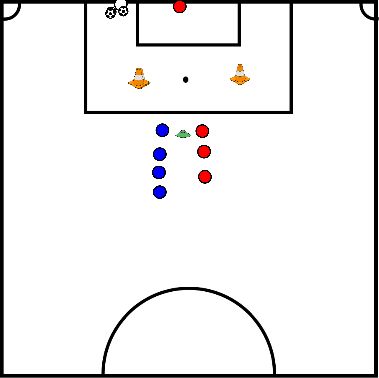
Goal of the exercise is to:
- Pass the ball into the boxes
- Score as many points as possible
- The opposing team's ball may be moved to another box by passing against it with the ball.
- In the youngest groups the distance from the green pawn to the scoring boxes is 5 meters, in the oldest groups it is 8 meters.
- The scoring boxes are 1 meter long and 3 meters wide.

- 2 players face each other
- One is the sender the other the receiver
- The receiver receives and rebounds
- The receiver dribbles sideways several meters without the ball
- The receiver receives the ball again
- The receiver dribbles back without the ball
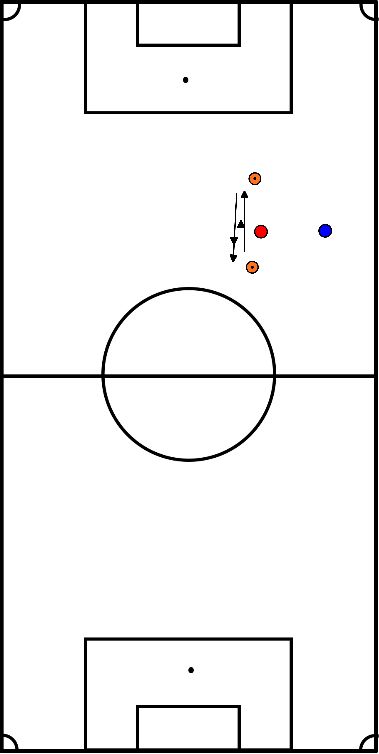
- The players stand to the side of their own goal
- The trainer gives everyone a number from 1-4
- The trainer calls out a number and whoever hears his number runs to the ball and plays against the other team where someone also has the same number
- After a few minutes more numbers will come into play
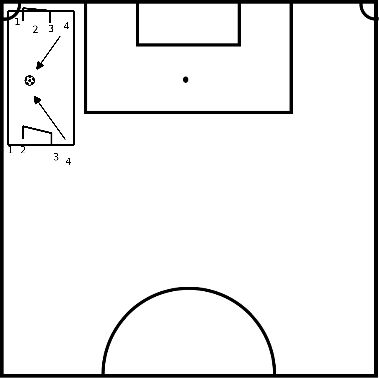
- Pass over the little goal
- Finish in the little goal

- Players shoot pointedly into the big goal
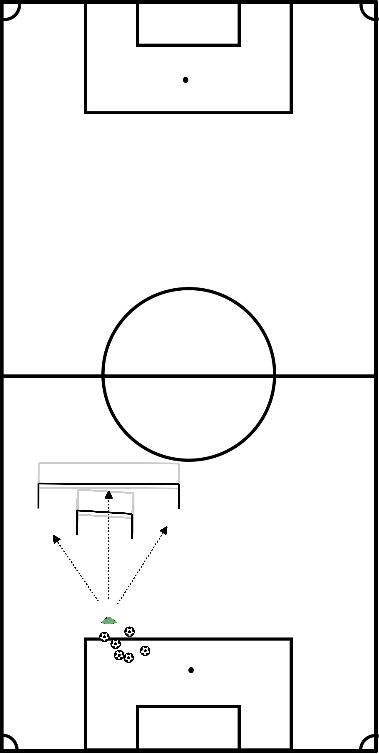
- The players walk to the right jar
- They then walk to the left jar
- Finally they walk to the middle potty
- Then they join the right group

- They pass straight through but slide across diagonally.
- When sliding through after the pass comes a warm-up exercise.

- Standing on one leg with a final goal of 10 seconds sustained with both legs.
- Attention: do not sink into the hip on the standing leg, keep knee slightly bent.
- If not successful, have knee extended or have children find light support from each other.
- Duration: +- 3 minutes.








